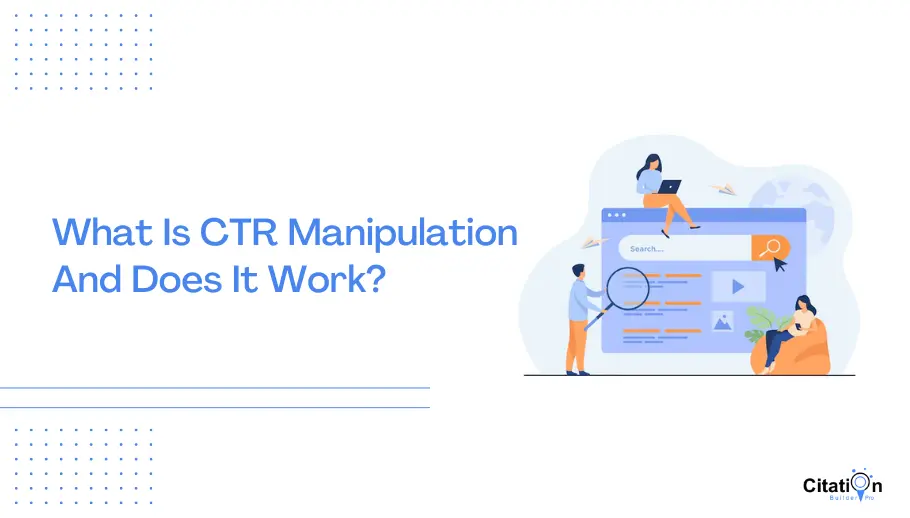Checking Out the Relationship Between CTR Adjustment Providers and Customer Actions
In the realm of electronic advertising and marketing, the impact of click-through price (CTR) adjustment solutions on user behavior stays a complex and interesting topic. By studying the intricate connection between CTR manipulation solutions and user habits, appealing insights arise that might reshape our understanding of electronic marketing strategies and their results on consumers.
Effect of CTR Manipulation on Habits
Examining the impact of Click-Through Rate (CTR) adjustment on customer habits discloses important understandings into the dynamics of online involvement. CTR control includes unnaturally pumping up the number of clicks on a certain link or promotion to deceive individuals and internet search engine. This method can result in a distorted assumption of a webpage's popularity or significance, inevitably affecting customer habits.

Moreover, CTR manipulation can skew the information utilized by formulas to individualize customer experiences. This can cause customers being offered material that does not straighten with their preferences or rate of interests, ultimately bring about a decrease in customer satisfaction and involvement. Recognizing the effect of CTR adjustment on user behavior is necessary for preserving openness and trust in online interactions.
Customer Involvement With Manipulated CTR
User involvement with adjusted CTR information often leads to manipulated perceptions of on-line content appeal and significance. When individuals communicate with material based upon artificially filled with air Click-Through Rates (CTR), they may think that specific info, products, or services are much more preferred or trustworthy than they really are. This can lead to individuals choosing based upon deceptive data, resulting in possibly negative outcomes.
Interaction metrics like sort, shares, remarks, and time invested on a page are usually affected by CTR control. Individuals may be much more likely to involve with content that appears to have greater interaction rates, even more bolstering the cycle of skewed perceptions. Consequently, material creators and advertisers may prioritize creating material that produces high CTR instead than focusing on producing genuinely valuable and appropriate product.

Mental Effects of CTR Adjustment

Moreover, the mental results of CTR control can also show up in altered decision-making procedures. Customers may be extra likely to click on content only based on its viewed popularity, as opposed to its real worth or relevance to their needs. This behavior shift can cause a surface interaction with on-line web content, where individuals might neglect premium however much less prominent offerings in favor of those with synthetically enhanced CTRs.
Fundamentally, the mental ramifications of CTR manipulation highlight the value of preserving openness and credibility in on-line communications to cultivate authentic user engagement and trust.
Ethical Factors To Consider in CTR Adjustment
CTR control elevates worries about deceiving customers, misshaping information analytics, and compromising the reputation of online web content. By artificially blowing up CTR, users might be deceived into clicking on web links or advertisements they would certainly not have selected otherwise, leading to a disingenuous online experience.
Another moral element to contemplate is the justness of controling CTR to get an unfair benefit over competitors. Involving in such techniques not just breaks concepts of justice however additionally weakens the trust fund that customers position in on the internet systems. It is necessary for businesses and digital marketing professionals to support honest standards in their techniques to guarantee transparency, trustworthiness, and long-term sustainability in the online atmosphere.
Effects for Digital Advertising And Marketing
With the increasing dependence on electronic systems for marketing purposes, the practice of adjusting click-through prices (CTR) presents significant implications for the performance and integrity of digital advertising and marketing methods. CTR control can bring about skewed information analytics, misinforming marketers right into believing that their projects are doing better than they in fact are. This can lead to misallocation of sources, with firms buying underperforming methods based on falsified CTRs. In addition, when individuals realize that CTRs have actually been adjusted, it can erode count on in the brand, resulting in long-lasting unfavorable consequences for client commitment and brand reputation.
Additionally, the use of CTR manipulation services can develop an unjust competitive basics landscape, where companies that participate in such techniques acquire a fabricated advantage over those that follow honest advertising and marketing criteria. This can why not try this out stifle development and imagination in electronic marketing, as success becomes even more about control methods than supplying genuine worth to consumers. Eventually, the implications of CTR adjustment for digital advertising expand beyond temporary gains, affecting the general sustainability and trustworthiness of advertising and marketing initiatives in the electronic realm.
Verdict
To conclude, the partnership between CTR control solutions and user habits is complicated and multifaceted. The effect of CTR control on actions, individual engagement with controlled CTR, emotional results, moral factors to consider, and implications for electronic advertising all contribute fit this connection. Recognizing these characteristics is essential for online marketers and researchers alike in order to browse the moral implications and take full advantage of the performance of their electronic marketing approaches.